Reynosa, Tamaulipas 作者: 来源: 发布时间:2021-07-23
1.Population and Area
Pop: 612,183
Area: 3,156.34 km2 (city)
Elev: 33 masl
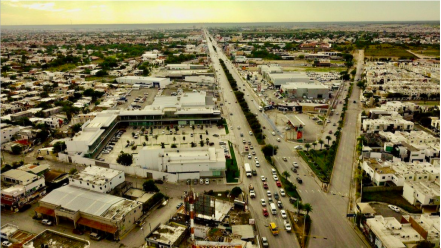
2. Natural geography
Nature and weather
The municipality of Reynosa is located in the center-north of the state of Tamaulipas between the geographical coordinates 25 ° 28 '- 26 ° 14' north latitude and 98 ° 09 '- 98 ° 36', its territory is mostly flat, fluctuating only between a maximum altitude of 300 and a minimum of 50 meters above sea level. Its territorial extension is 3 156.34 square kilometers that represent 3.7% of the total extension of Tamaulipas.
It limits to the northwest with the municipality of Gustavo Díaz Ordaz, to the east with the municipality of Río Bravo and to the south with the municipality of Méndez; to the west it borders the state of Nuevo León, in particular with the municipality of China and the municipality of General Bravo; to the north it limits with the state of Texas of the United States, corresponding its limits to the County of Hidalgo.
Orography and hydrography
The municipality of Reynosa is made up, fundamentally, by plains and mountains, a desert area of very low altitude, fluctuating between 300 and 50 meters above sea level. The decrease in altitude occurs in a southwest-northeast direction, accentuated by the Rio Grande Valley and the coastal plain of the Gulf of Mexico.
The two main hydrological currents in the municipality are the Río San Juan and the Río Bravo. The main source of supply is represented by the San Juan River, which provides irrigation and water for the city and irrigates the southern part of it. There are countless channels, the main ones being the Rhode and the Anzalduas.
Ecosystem
The flora contains abundant thorny bushes such as: granjeno, huizache and mesquite, as well as pyramidal grass, which is a good natural forage. In the southern part of the Municipality, low forests abound, predominantly spiny short trees and seasonal trees of various species.
Regarding the fauna, in the northern part and center of the city of Reynosa the white-winged dove, which is migratory, and flocks of wild birds abound; as well as the coyote, raccoon badger and opossum. The white-winged pigeon and the coyote are in danger of extinction. That is why it is important that we take care of these species to prevent them from becoming extinct, since if they become extinct, many ecosystems could be broken and that would negatively impact the way of life of the living beings that inhabit Reynosa.
Classification and Land Use
Three types of soil are easily distinguished. In the northern part of the Municipality the calcareous cambisol soil predominates; in the central and lower part, the soil xerosol, alkalic xerosol and calcareous xerosol and finally, in the lower southern part, the lithosol soil. As you can see, these soils are suitable for agriculture and livestock. The land for the most part is dedicated to agriculture, taking advantage of irrigation systems.
https://es.wikipedia.org/wiki/Municipio_de_Reynosa
Köppen Classification: Mid-Latitude Steppe and Desert Climate
This climate type is characterized by extremely variable temperature conditions, with annual means decreasing and annual ranges increasing poleward, and relatively little precipitation. This climate is typically located deep within the interiors of continents and is contiguous with the tropical desert climates of North and South America and of central Asia. This region type owes its origins to locations deep within continental interiors, far from the windward coasts and sources of moist, maritime air. Remoteness from sources of water vapor is enhanced in some regions by mountain barriers upwind.
The Köppen Climate Classification subtype for this climate is "Bsh". (Mid-Latitude Steppe and Desert Climate).
The average temperature for the year in Reynosa is 73.0°F (22.8°C). The warmest month, on average, is July with an average temperature of 84.0°F (28.9°C). The coolest month on average is January, with an average temperature of 60.0°F (15.6°C).
The highest recorded temperature in Reynosa is 104.0°F (40°C), which was recorded in August. The lowest recorded temperature in Reynosa is 12.0°F (-11.1°C), which was recorded in February.
The average amount of precipitation for the year in Reynosa is 31.2" (792.5 mm). The month with the most precipitation on average is September with 5.8" (147.3 mm) of precipitation. The month with the least precipitation on average is February with an average of 1.5" (38.1 mm). In terms of liquid precipitation, there are an average of 58.4 days of rain, with the most rain occurring in September with 8.8 days of rain, and the least rain occurring in February with 2.2 days of rain.
https://www.weatherbase.com/weather/weather-summary.php3?s=189367&cityname=Reynosa%2C+Tamaulipas%2C+Mexico&units=
Getting there and around
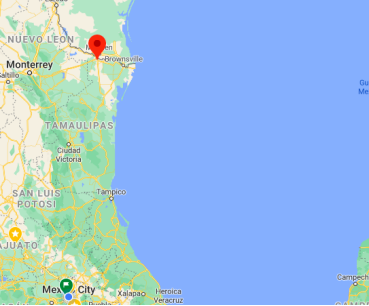
Get there
By plane
Reynosa's small regional airport is General Lucio Blanco Airport (IATA: REX), it is located about 5 miles southeast of downtown on Mexico Highway 2 (also known as "Libramiento Monterrey" at this point). The airport handles domestic flights only and is served by Volaris, AeroMexico, VivaAerobus, and Interjet.
U.S. passengers can fly into neighboring McAllen (IATA: MFE), which is served by Allegiant, United, and American, and then take a taxi or city bus to the Hidalgo border crossing.
By car
From points in south Texas, take U.S. 83 to McAllen and then exit at 23rd Street (route 115) and head south about 6 miles to the international bridge checkpoint at Hidalgo.
From points in Mexico:
·Mexico Highway 2 runs parallel to the border and can be used to reach Reynosa from other border cities.
·Mexico Highway 40 (toll road) can be used to reach Reynosa via Monterrey. The toll is 180 pesos.
The Aduana office to get car import permits is on Alvaro Obregon, just a few blocks to the left as you cross into Reynosa (go left on Miguel Aleman --- it turns into Obregon --- the office is on your left just after you round the bend).
By bus
It takes about 2 hours to get from McAllen, TX to Reynosa, Tamaulipas, including the wait for the bus.
Car Rental – To explore Mexico’s provincial towns and cities—including its beach locations and the scenery and attractions near them— consider renting a car for your visit. Having your own car will give you more flexibility than using public transport options and, in some cases, offer you access to places which are otherwise difficult to visit without the use of a car.
There are several car rental agencies. Rent something modest and unassuming.
COVID19 - International entry into Mexico from United States
Allowed for: All visitors arriving by air. Mexico land borders are closed to non-essential travel
Restricted for: There are no current restrictions.
https://www.rome2rio.com/s/Mexico-City/Matamoros
https://www.rome2rio.com/s/Houston/Matamoros
Get around
In brief, in order to get around Reynosa you could either: walk, (many people don't have a car) drive, take the bus, or bike. It is said to be that in some parts of Mexico like Reynosa, they don't respect bicyclers or walkers that are on the street. That is why the choices for most people really narrow down to: drive, or take the bus. Of course many people still walk or bike in the streets, but majority does not.
Local Buses – Local buses and mini-buses (combis or micros) are available locally for a fraction of the cost of a taxi around town. You need to speak Spanish to be able to ask for directions or ask the driver to tell you where to get off.
Taxis – Taxis in most of Mexico’s towns and cities are not metered, so agree your price before you get in. Taxi travel is very affordable in Mexico, in comparison to the USA, Canada and Europe, and so provides a viable means of public transportation in Mexico. Your hotel can arrange taxis for you; some post their rates on a board in the lobby; taxi hotel rates are usually higher than cabs you hail off the street. If you speak Spanish, you will have a distinct advantage and be able to negotiate a price with the driver.
Uber is expanding rapidly across Mexico and now offers services in cities across the country, including: Mexico City, Toluca, Cuernavaca, Puebla, Querétaro, León, Aguascalientes, San Luis Potosí, Guadalajara, Monterrey, Hermosillo, Tijuana, Mexicali, and Mérida. Uber has been adding Mexican cities to its network every year, check for availability when you arrive at your destination in Mexico.
Cabify and Didi are also developing and currently operate in cities including Mexico City, Toluca, Monterrey, Puebla, Querétaro and Tijuana. Check for availability in the city you are visiting.
These services offer people with smartphones a way to book a cab through a mobile app for a pre-agreed price. Fares are comparable with Sitio type cabs, and sometimes trade at a premium to this when local demand increases.
https://www.mexperience.com/transport/taxi-travel-in-mexico/#51
3. GDP
GDP: 13.08 M USD
4. Industry characteristics
The most important sectors are the Maquiladora Export Industry, being the third national in concentration of employment in this sector.
The extraction of natural gas in the Burgos Basin located in this area is of special interest to companies in the national and foreign oil sector.
Relatively recently, the wind sector has placed Reynosa in an interesting position by building here one of the largest wind power generation parks in Latin America.
Due to its geographical location, foreign trade occupies part of the economy of both cargo transport services, as well as customs and trading agencies. It has three international bridges and the Reynosa - Pharr bridge crosses about 2,000 trucks daily. It is the number one crossing nationwide for perishables.
Reynosa is a productive city with high economic activity, its population concentration reaches one million inhabitants for the entire metro area, so the demand for consumer goods is important.
https://www.rbctamaulipas.com/informacion
Tourism
The municipality has enough natural attractions, historical and architectural buildings of all kinds, which attracts many visitors, and this represents an important factor in economic development to become, in a short time, a destination requested by national and international travelers. There are virgin beaches that have not been exploited due to the lack of diffusion, but which are visited by inhabitants of the municipality and others.
https://www.ecured.cu/Reynosa_(M%C3%A9xico)
Key project: Wind Energy Project "Delaro"
The project consists of the design, construction and operation of a wind farm with a capacity of 117 MW located on 3,313 hectares of private property. The components of the project include the installation of approximately 27 wind turbines and the construction of a collecting substation to receive power through overhead cables. The collecting substation will raise the voltage to 230 kV and a 230-kV overhead transmission line will be built to transmit the electricity to the grid.
The electricity produced by the Project will be purchased by a group of commercial and industrial users under various long-term power purchase and sale contracts.
The purpose of the Project is to increase the installed capacity for the generation of renewable energy, which will help prevent the emission of greenhouse gases and other pollutants produced in generation plants that use fossil fuels. The Project is expected to produce approximately 475.9 gigawatt-hours (GWh) of electricity during the first year of operation.
https://www.nadb.org/es/nuestros-proyectos/proyectos-de-infraestructura/proyecto-de-energia-eolica-delaro-en-reynosa-tamaulipas
5. Attractions
Reynosa Historic Museum
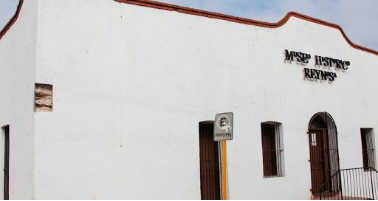
The Reynosa Historical Museum is a place that has a diversity of objects and elements that have a great historical and cultural meaning that should be visited by all kinds of people and especially by students.
The 28-year-old museum is open to the public and has fossils over 150 million years old, including documents from the vice-royal era, the Reformation and the Mexican Revolution.
Among its treasures are old weapons, prehistoric turtles, a glass that dates from 1904, coins, bills from much earlier times, carved wooden furniture, religious works, photographs that speak of the history of Reynosa.
European objects of Gothic type, also Argentine, among other things.
The Museum is open from Tuesday to Friday from 9:00 a.m. to 2:00 p.m. and from 4:00 p.m. to 8:00 p.m. On Saturday from 10:00 a.m. to 2:00 p.m. and Sunday as well. On Mondays it closes its doors.
https://www.posta.com.mx/tamaulipas/museo-historico-reynosa-mucho-que-contar
Reynosa Cultural Park
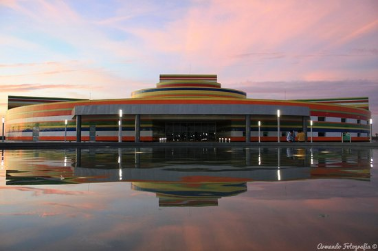
Located in a space of 40 hectares, in which the La Escondida lagoon is located. Its objective is to promote cultural and artistic activities, as well as carry out programs for the development of arts, culture and artistic activities in the municipality of Reynosa and the border region. It has an ideal theater for the expression of all artistic disciplines such as theater, cinematography, dance, opera, concerts, as it has the highest technology in theater mechanics, audio and lighting. It also offers exhibition galleries and a Convention Center.
Six of the 40 hectares of the park them belong to the Center of Art and Culture and the rest to the ecological park that surrounds it. The Center for Art and Culture building has two theaters: a main one with a capacity for 1,146 people and an orchestra pit and an experimental one with a capacity for 400 people; It also has an exhibition gallery of 852 square meters and a convention room for 500 people.
It is the venue for activities such as concerts, plays, painting exhibitions, photography, cinema, conferences and activities to promote reading. However, the notoriety that the place has gained added to the breadth of its spaces has generated that even some Public political activities take place there, such as public sessions of the Tamaulipas State Congress and government reports from the mayors of Reynosa.
https://www.zonaturistica.com/en/things-to-do/tamaulipas/reynosa/parque-cultural-reynosa
https://porcewol.com.mx/parque-cultural-reynosa-tamaulipas-porcewol-by-alfher
Reynosa Cathedral
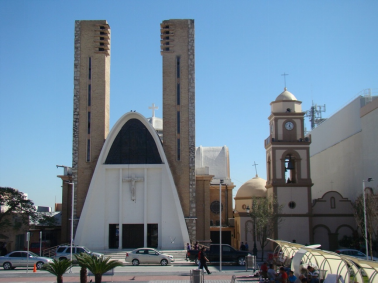
The bell tower of the parish of Our Lady of Guadalupe, which dates back 180 years, is the main legacy that has been had since the founding of this city, on March 14, 1749.
The bell tower located in the first square of this border city is the oldest and most representative piece of the architectural legacy that has been preserved for 180 years. According to history, in the years from 1799 to 1803 the legal process of the transfer of the Villa de Reynosa, about 22 kilometers away, to the Loma de San Antonio, today Reynosa, was carried out due to meteorological circumstances that they caused a flood in the summer of 1802.
In 1803, the buildings in this area were called jacales and the first church that was built consisted of three jacales.
It was in 1810 when the church began to be built with another type of material, but since no progress was made, its construction was postponed.
It was not until 1835 when the first stage of building the lime and stone of the old temple of Our Lady of Guadalupe, begun 25 years earlier, was completed. In 1835, the construction was made that consisted of a deep, narrow and rustic gallery that had a design in the shape of a Latin cross, with two side chapels, a sacristy and the church bell tower. The upper part of the bell tower houses a clock that was brought from Europe, and which was incorporated in the year 1898.
The bell tower is the only thing that remains today of the first temple that was demolished in 1950 for the construction of the new modernist parish that was consecrated in 1956.
In its beginnings, this area was inhabited in a higher percentage by indigenous people, whose language was comecrudo and who were very fond of religious festivities. The Comecrudo language is known from word lists compiled during the 18th and 19th centuries among the tribes that lived along the lower reaches of the Rio Grande in southern Texas and northern Mexico.
The most significant ceremony among the Indians was the one where they expressed their religious beliefs, at the same time it was a ritual that maintained the social cohesion of the tribe.
With the arrival of the Spanish in this area, the religion gained more strength and for this reason the friars who dominated the region ordered the construction of churches and temples.
https://www.posta.com.mx/tamaulipas/campanario-de-reynosa-legado-historico-de-hace-180-anos
6. History
The town of Nuestra Señora de Guadalupe de Reynosa (it should be noted that the original name was written with a Latin "i" like its Spanish namesake) was founded on March 14, 1749, by the exploration of a Spanish colonizer ten leagues below the annexes of the San Juan and Bravo rivers, on the south bank of the latter. The town of Reinosa arises after the town of Camargo was established when Colonel José de Escandón ordered the foundation of a second town on the banks of the Rio Grande, ten leagues below.
Reynosa was baptized like this, in honor of the place of origin of the then viceroy of New Spain Juan Francisco de Güemes y Horcasitas, first Count of Revillagigedo, since said viceroy was a native of the Spanish population of Reinosa located in Cantabria (Spain). The new town was consecrated to the Virgin of Guadalupe by the Franciscan friars, who were entrusted to evangelize the native population.
The foundation of Reinosa was the work of an extraordinary colonizing project headed by Don José de Escandón and Helguera, while Carlos Cantú was the first Captain and Chief Justice of the Villa.
Reynosa was planted in an extensive alluvial plain, in the habitual abode of the Comecrudos, Tejones, Pintos and Pajaritos Indians as well as displaced groups from the Nuevo Reino de León such as Sacatiles, Nazas and Narices. Its original settlers were mostly from the Nuevo Reino de León, which included a list of 41 heads of families and eleven soldiers and their families from the local squad, which had a total of 223 people.
The colonial life of Reinosa is divided into three stages: the first was its foundation, followed by the stage of the Bravo floods that paralyzed its development, and finally, it was characterized by the transfer of the population and its powers downstream, to the Hills of San Antonio (place where the current Reynosa is located). From this New Spain period, the only architectural testimony that survives is the bell tower of the old parish church, the Church of Our Lady of Guadalupe, which was founded in 1835 and is the oldest construction in the city.
It was not until the early years of the twentieth century, that due to a spelling error in the minutes, writings and official communications of the city council of the then Villa de Reinosa, the Greek "y" began to be used replacing the Latin "i" for Calling the town, which became a custom and as a consequence the name is currently Reynosa, which until 1926 was promoted to the category of city by official decree.
7.Contact Information
City Mayor: Maki Esther Ortiz Domínguez

Contact number: +52 (899) 932 3200
Govt. Office Address: Morelos No. 645 entre Hidalgo y Juárez, Zona Centro
FB: https://www.facebook.com/MakiOrtiz
Twitter: https://twitter.com/MakiOrtizD
Website: https://www.reynosa.gob.mx
E-mail: maki.ortiz@reynosa.gob.mx
